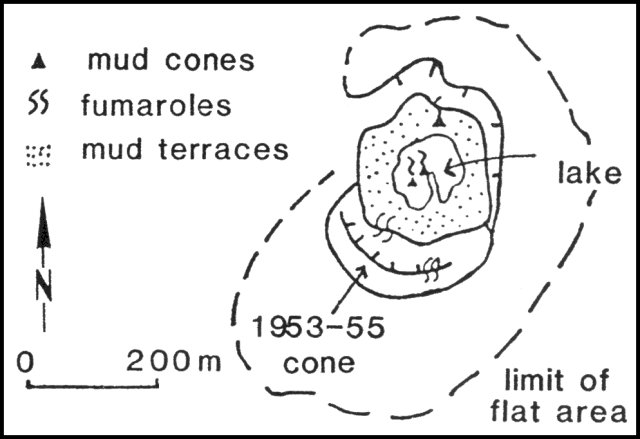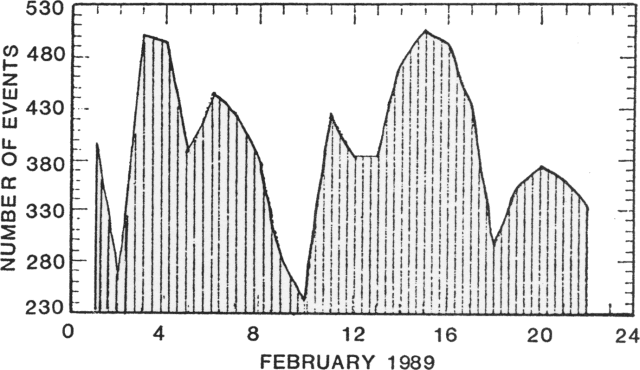Report on Poas (Costa Rica) — February 1989
Scientific Event Alert Network Bulletin, vol. 14, no. 2 (February 1989)
Managing Editor: Lindsay McClelland.
Poas (Costa Rica) Crater lake continues to shrink
Please cite this report as:
Global Volcanism Program, 1989. Report on Poas (Costa Rica) (McClelland, L., ed.). Scientific Event Alert Network Bulletin, 14:2. Smithsonian Institution. https://doi.org/10.5479/si.GVP.SEAN198902-345040
Poas
Costa Rica
10.2°N, 84.233°W; summit elev. 2697 m
All times are local (unless otherwise noted)
The crater lake has continued to shrink, and by the end of February, the cumulative decrease in depth was estimated at 30 m. The lake was only 10-15 m deep and its diameter was 100-125 m (figure 9). Seven dessication terraces surrounded the lake, which was colored gray by solutes and suspended mud. The lake contained multiple centers of convective bubbling. Mud plumes were rarely ejected, some with small blocks that fell back into the lake. On the N shore and in the south-center of the lake there were small mud/sulfur cones with fumaroles. Fumarolic activity on the 1953-55 [dome] had declined, with only a few vents remaining on the summit; most were on the N flank of the [dome], toward the lake. Their temperature was at about the boiling point of water at that elevation, approximately 95°C. February seismic events, mostly B-types, totaled 8,639 through the 22nd, for a daily mean of 392 (figure 10).
 |
Figure 9. Sketch map of the crater lake and 1953-55 [dome] at Poás, February 1989. Courtesy of G. Soto and Mario Fernández. |
 |
Figure 10. Daily recorded seismic events at Poás, February 1989. Courtesy of G. Soto and Mario Fernández. |
[The following was inadvertently omitted from the original 14:02 report.]
On 12 February 1989, geologists from Italy (M. Martini, L. Giannini, M. Paolieri, and F. Prati), the Univ Nacional (J. Barquero), and the Instituto Costarricense de Electricidad (J. Fernández) collected gas samples from fumaroles on the almost dry lake bottom within the active crater, and from a residual boiling pond. Analysis of gas samples yielded the following values (in mole %): CO2, 79.5; H2S, 5.0; H2, 0.2; CO, 0.0004. The pond had high concentrations of sulfuric and hydrochloric acid. The Italian geologists noted that these values suggest an important contribution from a shallow degassing magma body, probably responsible for the collapse of the pre-existing [dome] and for the fracturing of the lake bottom that facilitated the disappearance of the lake.
Geological Summary. The broad vegetated edifice of Poás, one of the most active volcanoes of Costa Rica, contains three craters along a N-S line. The frequently visited multi-hued summit crater lakes of the basaltic-to-dacitic volcano are easily accessible by vehicle from the nearby capital city of San José. A N-S-trending fissure cutting the complex stratovolcano extends to the lower N flank, where it has produced the Congo stratovolcano and several lake-filled maars. The southernmost of the two summit crater lakes, Botos, last erupted about 7,500 years ago. The more prominent geothermally heated northern lake, Laguna Caliente, is one of the world's most acidic natural lakes, with a pH of near zero. It has been the site of frequent phreatic and phreatomagmatic eruptions since an eruption was reported in 1828. Eruptions often include geyser-like ejections of crater-lake water.
Information Contacts: G. Soto and Mario Fernández, Univ de Costa Rica, San José; M. Martini, Univ di Firenze, Italy.

